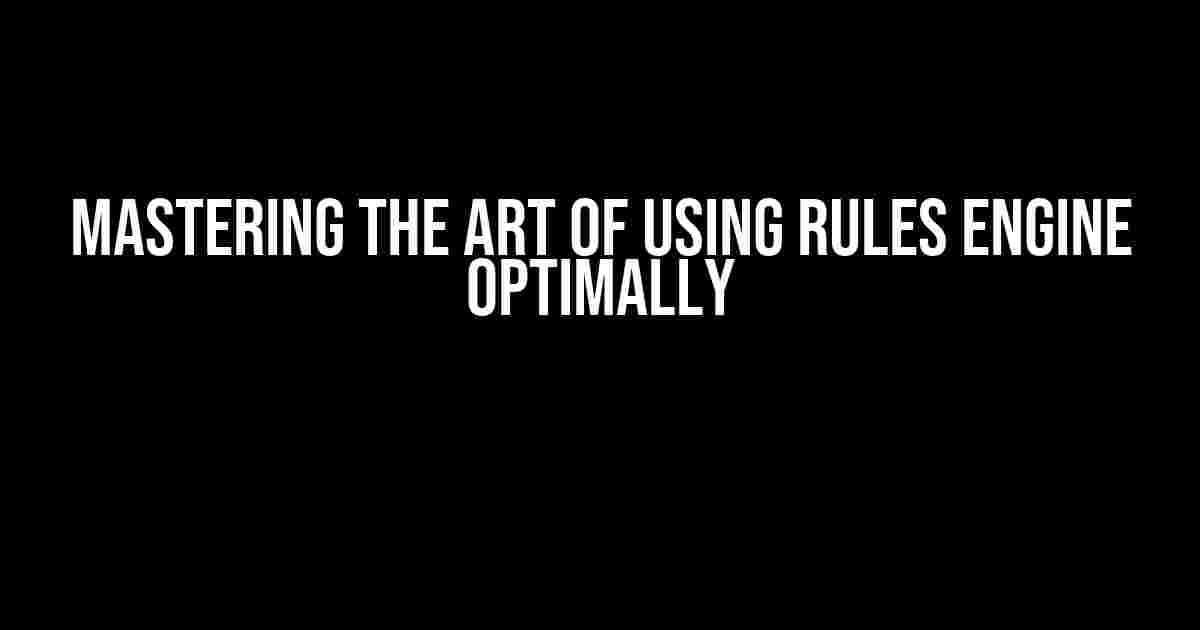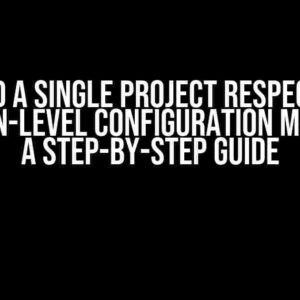Are you tired of manually processing complex business rules, only to find yourself stuck in a web of conditional statements and logical deductions? Do you dream of streamlining your decision-making processes and automating tedious tasks with ease? Look no further! In this article, we’ll delve into the world of rules engines and provide you with a comprehensive guide on using them optimally.
What is a Rules Engine?
A rules engine is a software component that enables you to separate business logic from application logic, allowing you to define, manage, and execute complex rules and decisions in a centralized and modular manner.
Benefits of Using a Rules Engine
- Improved decision-making: Rules engines enable you to make informed decisions based on precise and up-to-date rules.
- Increased efficiency: Automate tedious tasks and free up resources for more strategic activities.
- Enhanced flexibility: Easily modify and update rules without requiring extensive coding knowledge.
- Better governance: Centralize and standardize rules across your organization, ensuring compliance and consistency.
Optimizing Your Rules Engine: Best Practices
To get the most out of your rules engine, follow these best practices to ensure optimal performance and efficiency.
1. Define Clear and Concise Rules
Clearly articulate and document your rules, avoiding ambiguity and ensuring that they are easily understood by both technical and non-technical stakeholders.
Rule Example: IF customer.age > 18 AND customer.country == "USA" THEN offer.discount = 10%
2. Organize Rules Logically
Structure your rules using a logical hierarchy, categorizing them by business domain, category, or type to facilitate easy maintenance and updates.
| Category | Rules |
|---|---|
| Customer |
|
| Product |
|
3. Use Decision Tables and Trees
Visualize complex rules using decision tables and trees, which enable you to model and execute rules in a concise and intuitive manner.
Decision Table: | Condition | Action | | --- | --- | | customer.age > 18 | offer.discount = 10% | | customer.country == "USA" | offer.discount = 10% |
4. Leverage External Data Sources
Integrate your rules engine with external data sources, such as databases, APIs, or file systems, to access real-time data and make informed decisions.
RuleExample rule = new RuleExample();
rule.setExternalData(new DatabaseDataSource("customer_data"));
5. Test and Refine Rules
Rigorously test your rules using various input scenarios and edge cases, refining them as needed to ensure accuracy and consistency.
- Test rule with sample data
- Verify rule output against expected results
- Refine rule based on test results
Common Pitfalls to Avoid
While using a rules engine can be a game-changer, it’s essential to avoid common pitfalls that can hinder its effectiveness.
1. Over-Engineering
Avoid over-engineering your rules by including unnecessary complexity, which can lead to maintenance nightmares and decreased performance.
2. Lack of Governance
Establish clear governance and ownership of rules, ensuring that they are properly maintained, updated, and version-controlled.
3. Insufficient Testing
Failing to thoroughly test rules can result in inaccurate or inconsistent decisions, which can have severe business implications.
Conclusion
By following these best practices and avoiding common pitfalls, you can unlock the full potential of your rules engine and transform your business decision-making processes. Remember to define clear and concise rules, organize them logically, use decision tables and trees, leverage external data sources, and test and refine rules regularly. With optimal use of a rules engine, you’ll be able to streamline processes, reduce costs, and make better-informed decisions that drive business success.
So, what are you waiting for? Start mastering the art of using rules engine optimally today and take your business to the next level!
Frequently Asked Question
Get the most out of your rules engine with these expert-approved tips and tricks!
How can I simplify my rules to improve performance?
Simplifying your rules is key to optimal performance! Break down complex rules into smaller, more manageable chunks. This will reduce the processing load and make it easier to maintain and update your rules. Additionally, consider using decision tables or decision models to visualize and simplify your rules.
What’s the best way to organize my rules for better reusability?
Organization is the name of the game when it comes to rules reusability! Create a clear hierarchy of rules and categorize them by business function or domain. Use naming conventions and tagging to make it easy to find and reuse rules across your organization. And don’t forget to document your rules with clear descriptions and explanations!
Can I use a rules engine for real-time decision-making?
Absolutely! Rules engines are perfect for real-time decision-making. With the right architecture and infrastructure, you can use a rules engine to make rapid-fire decisions based on incoming data. Just be sure to optimize your rules for performance and consider using in-memory data grids or other high-performance technologies to minimize latency.
How do I handle exceptions and errors in my rules engine?
Error handling is crucial in rules engines! Implement a robust error-handling mechanism that can detect and respond to exceptions and errors in real-time. Use logging and auditing to track errors and identify areas for improvement. And don’t forget to test your error handling with simulated scenarios to ensure it’s working as expected!
What are some best practices for testing and validating my rules?
Testing and validation are critical! Develop a comprehensive testing strategy that includes unit testing, integration testing, and regression testing. Use data-driven testing to validate your rules against different scenarios and edge cases. And don’t forget to involve business stakeholders in the testing process to ensure your rules align with business requirements!


